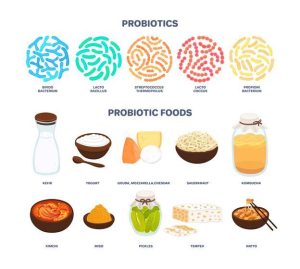
Digestive aids and gut health. Natural foods, supplements, and some drugs that aid in the breakdown of food for the absorption of nutrients are examples of digestive aids. Natural digestive enzyme-rich foods like pineapple, papaya, and ginger can help with digestion, and prescription medications and over-the-counter supplements like antacids, proton pump inhibitors, and enzyme replacements can help with digestive problems like bloating, gas, and vitamin deficiencies. By including these seven digestive aids into your daily routine, you can improve digestion, boost gut health, and elevate your general well-being. Supporting your digestive system, whether through food choices, supplements, or herbal therapies, guarantees that you maintain a balanced gut microbiota and absorb nutrients effectively.
DIGESTIVE AIDS AND GUT HEALTH
This article offers a thorough analysis of several digestive aids, emphasizing their advantages and practical ways to incorporate them into daily life to promote digestive health. Overall health is largely dependent on digestive health, which affects everything from immunological response to nutrition absorption. Optimized digestion and gut health can be greatly enhanced by incorporating digestive aids into your everyday routine.
1. Probiotics;

Probiotics are beneficial bacteria that contribute to a healthy gut microbiome. They help maintain a balanced intestinal environment, support digestion, and enhance immune function. Yogurt, kefir, kombucha, and fermented vegetables like sauerkraut and kimchi are rich sources of probiotics.
2. Digestive Enzymes:
These enzymes help break down carbohydrates, proteins, and fats into smaller molecules that are easier for the body to absorb. Supplemental digestive enzymes can aid individuals with digestive disorders or those who have difficulty digesting certain foods.
3. Fiber:

Digestive aids and gut health
A diet rich in fiber promotes regular bowel movements and supports digestive health by preventing constipation. Fiber also acts as a prebiotic, feeding beneficial bacteria in the gut. Whole grains, fruits, vegetables, nuts, and seeds are excellent sources of dietary fiber.
4. Ginger;
Known for its anti-inflammatory properties, ginger can help alleviate digestive discomfort such as bloating, gas, and nausea. It stimulates digestive enzymes and promotes smooth muscle contractions in the gastrointestinal tract, aiding in digestion.

Digestive aids and gut health
Peppermint oil and tea are commonly used to relieve symptoms of indigestion and irritable bowel syndrome (IBS). Peppermint relaxes the muscles of the digestive tract, easing spasms and promoting the flow of bile, which aids in digestion.
6. Hydration:

Drinking an adequate amount of water throughout the day is essential for maintaining digestive health. Water helps dissolve nutrients and fiber, facilitating their passage through the digestive system. Dehydration can lead to constipation and other digestive issues.
7. Chamomile;

Digestive aids and gut health
Chamomile tea has been used for centuries to soothe digestive discomfort, reduce inflammation, and promote relaxation. It can help alleviate symptoms of indigestion, such as bloating and gas, by calming the stomach muscles and supporting overall digestive function.
Summary
Probiotic-rich fermented foods like yogurt and kimchi, as well as a diet heavy in fruits, vegetables, and whole grains, are aids for gut health. Changing one’s lifestyle to include regular exercise and stress reduction is also essential for gut health. Supplements like digestive enzymes or prebiotics may help some people with certain problems, but before taking any new supplements, it’s best to speak with your doctor.
Pingback: 6 Fruits That Are Not Recommended for Pregnant Women